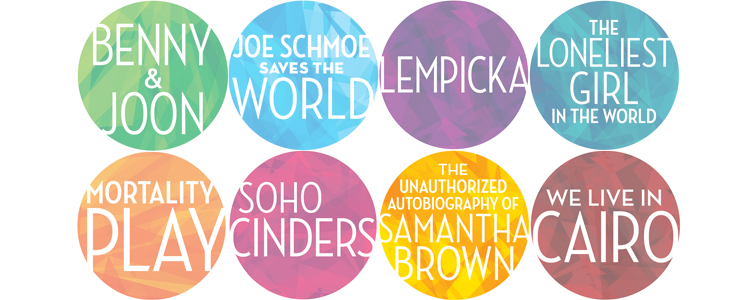A guest blog post by Kait Kerrigan, one of the writers of this year’s Festival show The Unauthorized Autobiography of Samantha Brown, written with Brian Lowdermilk.
Choosing your collaborators is always a challenge. As writers in a long-term collaboration, it’s also an opportunity to inject life and breath into a project. When we applied to NAMT, it was with the intent of stripping down our piece to its strongest elements and making it feel fresh and relevant. We’re writing about a teenage girl who is dealing with her first brush with grief. There is a large canon of literature that plunges into those depths but we have approached it with a heightened theatricality that we think makes it feel fresh and newly emotional. We were looking for collaborators who could help us look at the piece from an entirely new angle. This meant that we were looking for people who had never worked on the project before.
Before we could find our dream collaborators, we had to name for ourselves what we wanted out of them and we knew a couple things from the outset: we wanted a director who would deep-dive into the text and we wanted a music director who would be so adept with the musicality of the piece that they would understand how to bring the actors into the musical dramaturgy of the piece rather than worry about plunking the notes. For the latter, we reached out to a good friend named Paul Staroba. We first met Paul at an open call for this show. He was the rare audition pianist who not only played literally every note on the page but infused it with musicality. On our lunch break, we took him to our favorite lunch spot in the 30s (an old Italian joint on 9th Ave that is sadly gone in this age of unrelenting gentrification) and discovered he had just arrived in New York City. In what seemed like minutes, he was swept up by some smart conductor and made the associate on a little show called Grey Gardens. We’ve been friends ever since and he remains one of our favorite players in New York. It’s been exciting to watch him flourish as a music director. He’s able to take his natural instincts about musical storytelling and instill that sensitivity in actors. Asking him to join us was a no-brainer.
Portia Krieger was a little harder to find because we didn’t know her. If you don’t know who your perfect collaborators are, I highly recommend asking your favorite collaborators for recommendations. Portia came with the highest praise from our collaborator Stephen Brackett, who said he was hesitant to give us her name because he was afraid we’d love her so much that we’d never call him again. Done. Our love for Stephen Brackett is such that I don’t think we’re in danger of only doing this one project with him but we are over-the-moon to have Portia’s sense of play and depth of emotion on this project. Even the one-line emails she sends have an impish beauty to them.
Every project is different but when it comes to actors, for us, it seems to always come back to finding strong unique women for the leading role. Every now and then, you come across a young woman who you immediately know is a star: Melissa Benoist, who played Kelly in a workshop production of this show, Jenni Barber, who also played Kelly, Celia Keenan-Bolger who once played Samantha. Prior to NAMT, we always focused on making sure that Sam and Kelly were opposites – that Kelly was funny and dynamic and Sam was deep and intensely smart but through some years of trial and error, we decided to really push the boundaries on casting Samantha. She is the star of the show – she is on stage for all but 5 minutes. She has to be the most dynamic person on stage. That was what led us to pursue Ciara Renée for our lead.
Thanks to Michael Cassara, the unsung best casting director in New York City – especially when it comes to finding new and exciting performers fresh out of college, we met Ciara weeks after she arrived in New York City. She did a workshop of The Bad Years for us. Pretty soon thereafter, she was the Leading Player in Pippin. Ciara is someone you can’t take your eyes off of. She is dynamic and irrepressible. We’re excited to see what happens when someone with her charisma plays someone who’s become somewhat repressed from the grief she feels. We think it will make the transformation that Sam goes through over the course of the show more extreme and inevitable.
Once we had Ciara the rest of the casting fell into place. We’re excited that we’ll be working with all new actors on this process – just as our creative team is coming to the piece for the first time. We think it will lead us to having an experience that organically allows us to look at the piece anew.
Opportunities like NAMT or any workshop are chances to open your work back up and try to see it again for the first time. If I have one piece of advice for other writers or for other creatives approaching a workshop of a piece – it’s to start from scratch on at least one thing in every process. Treat it like a scientist would treat an experience. Allow yourself to have a control and a variable. How does this variable affect your results? In our case, it happens to be our collaborators. Our control is the artistic goals we set out for the piece years ago: to write a piece that is small but universal. We’re hopeful that by changing up this variable, we’ll be able to achieve a new level of clarity on our constant goal.


